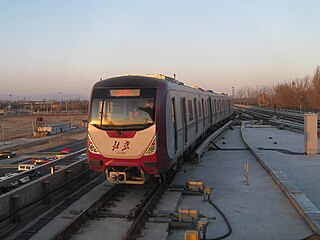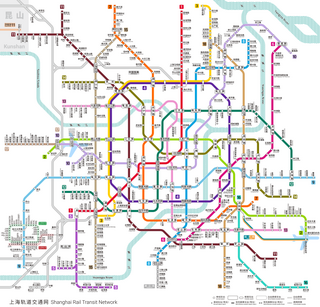
The Beijing Subway is the rapid transit system of Beijing Municipality that consists of 27 lines including 22 rapid transit lines, two airport rail links, one maglev line and 2 light rail lines, and 490 stations. The rail network extends 836 km (519 mi) across 12 urban and suburban districts of Beijing and into one district of Langfang in neighboring Hebei province. With 3.8484 billion trips delivered in 2018, an average of 10.544 million trips per day, the Beijing Subway is the world's busiest metro system. Single-day ridership set a record of 13.7538 million on July 12, 2019.

Line 1 is a north–south line of the Shanghai Metro. It runs from Fujin Road in the north, via Shanghai Railway Station to Xinzhuang in the south. The first line to open in the Shanghai Metro system, line 1 serves many important points in Shanghai, including People's Square and Xujiahui. Due to the large number of important locations served, this line is extremely busy, with a daily ridership of over 1,000,000 passengers. Generally, the line runs at grade beside the Shanghai–Hangzhou railway in the south, underground in the city center and elevated on the second deck of the North–South Elevated Road in the North. The line is colored red on system maps.

The Chengdu Metro is the rapid transit system of Chengdu, the capital of Sichuan, China. With the opening of Line 1 on 27 September 2010, the system consists of 13 subway lines and 1 light rail line. It has subsequently undergone rapid expansion. Since the opening of Lines 6, 8, 9, and 17 on 18 December 2020, the Chengdu Metro is the 4th longest metro system in the world.

Urban rail transit in China encompasses a broad range of urban and suburban electric passenger rail mass transit systems including subway, light rail, tram and maglev. Some classifications also include non-rail bus rapid transport. As of 31 December 2022, China has the world's longest urban rail transit system with more than 9,500 km (5,900 mi) of urban rail nationwide in 49 systems in 47 cities, accounting for 9 of the 10 longest metro systems except Moscow Metro, or metro systems in Seoul combined if metro systems in the same cities are merged in the rank.

Line 10 is a southwest–northeast line of the Shanghai Metro network. It officially opened for service on April 10, 2010. The line runs from Jilong Road to Hongqiao Railway Station, with a branch line from Longxi Road to Hangzhong Road. It has been given the unofficial nickname “Golden Line” as it links many of the city's tourist attractions like Yuyuan and Xintiandi. It connects the Hongqiao International Airport with the downtown core of Shanghai, and also the dense residential districts of Yangpu and Hongkou. It is the only line in the system with numbered station codes. It is the first high-density and high-volume fully automatic subway line in Mainland China, operating with GoA4 unattended train operation. The line is colored lilac on system maps.
CRRC Dalian Co., Ltd., often abbreviated as DLoco, is a company located in Dalian, Liaoning Province, China, producing railway locomotives, multiple units and diesel engines.

All Beijing Subway trains run on 1,435 mmstandard gauge rail and draw power from the 750 V DC third rail, except those on Lines 6, 11 14, 16, 17 and 19, which use 1,500 V DC overhead wires. Lines 6, 15, Fangshan, and Changping lines have a designed maximum service speed of 100 km/h (62 mph). The Airport Line is linear motor driven with a designed maximum service speed of 110 km/h (68 mph) All other Lines have a maximum service speed of 80 km/h (50 mph). Currently, Lines 1, 2, 4, 5, 8, 9, 10, 13, 15, Batong, Daxing, Changping, Fangshan, Yanfang, and Yizhuang lines use 6 car B size trains. Initially, the Batong line and Line 13 was originally used 4 car trains and now expanded into six.

Line 16 of the Beijing Subway is a rapid transit line in Beijing. It is 48.9 km (30.4 mi) in length with 30 stations. The line is fully underground.
CRRC Shandong Co. Ltd., formerly also known as JRVEC, is a railway rolling stock factory located in Jinan, Shandong, China, established in 1910 as a workshop of the Jinpu Railway.

Several cities in China had tram systems during the 20th century; however, by the end of the century, only Dalian and Changchun remained extant. However the 21st century has seen a resurgence in tram transport systems as China attempts to combat with urban traffic congestion and pollution.

Ningbo Railway Station is an underground metro station of Line 2 and Line 4 in Ningbo, Zhejiang, China. It situates under the station building of Ningbo Railway Station of China Railways. Passengers can transfer to intercity trains without going out of the station. Construction of the station started in late 2010, Line 2 station opened to service on September 26, 2015, and Line 4 station opened to service on December 23, 2020.
Shanghai Shentong Metro Group Co., Ltd. known as Shentong Metro Group is the operator of Shanghai Metro and Shanghai Maglev Train, as well as the parent company of the listed company Shanghai Shentong Metro Co., Ltd. It is currently responsible for the operation of Shanghai Metro. This includes investment, financing and operation management, and owns most of the assets of Shanghai Metro. The name is derived from Shen is the alternative name of Shanghai, while Tong literally means transportation.

Line 5 of CRT is a rapid transit line in Chongqing, China, which opened on 28 December 2017.

Wuhu Rail Transit is a two-line monorail rapid transit system in Wuhu, Anhui, China. Both lines use Bombardier Innovia Monorail 300 trains manufactured under a joint venture with CRRC. Line 1 opened on 3 November 2021, with Line 2 opening on 28 December 2021.

Songjiang Tram is a light rail tramway in Shanghai, China. The system consists of two lines totaling 31 km (19 mi) with 42 stations. Unlike the Zhangjiang Tram, Songjiang trams use centenary power supply and steel-wheeled rail systems. Most of them use independent rights of way. The intersection signal lights were adjusted through the system to make them pass first, and the running speed reaches 25-30km/h. Trains run from 6:00 till 22:00. With further extension of the network public transport modal split in Songjiang is expected from the current 23% to 40%.
Tianshui Tram is a light rail system consisting of one route in Qinzhou District and Maiji District, Tianshui, Gansu, China.

Line 17 of the Chengdu Metro is a metro line in Chengdu. The whole line will be 30.286 km when Phase 2 opens. The line uses 8-car Type-A trains operating up to 140 km/h speed powered by 25kV AC overhead lines.

Shanghai Rail Transit includes all rail transit lines operating in Shanghai, mainly composed of High-volume railway system, Low-to-medium-volume railway system and Maglev system. The system was established on May 28, 1993, when Shanghai Metro Line 1 opened.

Nanjimen Yangtze River Bridge is a rapid transit cable-stayed bridge that crosses the Yangtze to connect Yuzhong and Nan'an Districts in Chongqing. The bridge carries Chongqing Rail Transit Line 10 trains. It opened on 18 January 2023.















